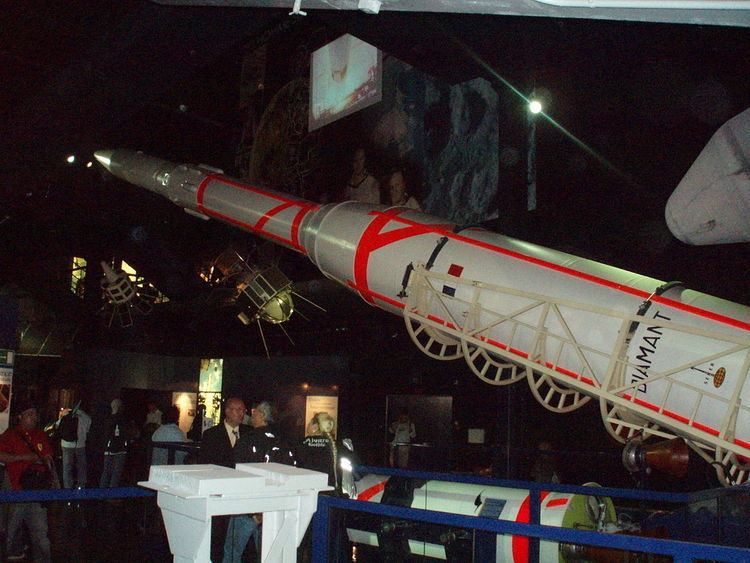Country of origin France Mass 18,400 kg (40,500 lb) | Manufacturer SEREB Diameter 1.34 m (4.39 ft) | |
 | ||
Height A: 18.95 mB: 23.5 mBP4: 21.6 m (A: 62.17 ftB: 77 ftBP4: 70.7 ft) | ||
The Diamant rocket (Diamant is French for "diamond") was the first exclusively French expendable launch system and at the same time the first satellite launcher not built by either the United States or USSR. As such it is the main predecessor of all subsequent European launcher projects. It was derived from the military program Pierres précieuses (fr.: gemstones) that included the five prototypes Agate, Topaze, Emeraude, Rubis and Saphir (Agate, Topaz, Emerald, Ruby and Sapphire).
Contents
Design of the Diamant began in 1962, as the inaugural spacecraft project of France's space agency, the CNES. Out of 12 launch attempts between 1965 and 1975, 9 were successful. Most notably, the Diamant was used to put the first French satellite, Astérix, into orbit on November 26, 1965. Despite the success, France abandoned its national launcher program in favor of the European Ariane launcher in 1975.
Three successive versions of the Diamant rocket were developed, designated A, B and BP4. All versions had three stages and a payload of approximately 150 kg for a 200 km orbit.
Diamant A
This was the first version of the Diamant rocket. It was used to launch the Astérix and subsequently three other small satellites during 1965-67 from the base at Hammaguir in Algeria. Remarkably for a newly developed system, all four attempted launched were partly successful, the only failure occurring on the second launch when the payload was inserted into a lower orbit than planned. It possessed a first stage of 10 m, 1.4 metres in diameter, and a weight of 14.7 metric tons. Their engines of the type LRBA Vexin supplied a thrust of 269 kN for 93 seconds. The second stage was 4.7 metres long and had a diameter of 80 centimetres. It weighed 2.9 metric tons and developed a thrust of 165 kN for a duration of 44 seconds. The third stage of 2.65 m in diameter. Its weight amounted to 709 kilograms. It burned for 45 seconds and developed a thrust of 27 kN to 53 kN. Completely installed, a Diamond A was 18.95 metres high and weighed 18.4 metric tons.
Diamant B
An improved version of the Diamant A with a more powerful first stage. Five satellite launches were attempted between 1970 and 1973, of which the last two failed. All launches took place from Kourou in French Guyana.
Its first stage was 14.2 meters long, had a diameter of 1.4 meters and weighed 20.1 metric tons. Its engine developed a thrust of 316 kN to 400 kN (as a function of the flight altitude) for 116 seconds. The second stage the Diamond B corresponded to that the Diamond A. The third stage was 1.67 meters long and had a diameter of 80 centimeters. It developed a thrust of 24 kN for 46 seconds. Completely assembled a Diamond B was 23.5 meters high and weighed 24.6 metric tons.
Diamant BP4
This version incorporated a new second stage, while carrying the first and third stages over from its predecessor. It performed three successful launches in 1975, putting a total of four satellites into orbit. Its second stage, which was derived from the MSBS rocket, was 2.28 metres long and 1.5 metres in diameter and developed a thrust of 180 kN for 55 seconds.
